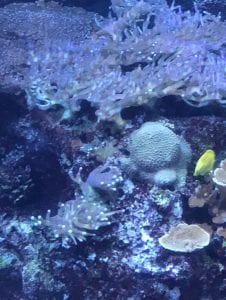One of the wonderful attractions that the city of Atlanta offers is the Georgia Aquarium. I decided to choose this place for my blog, as it has always been a fascinating site for me to observe and learn more about marine life. I took my time to explore many of the areas in the Aquarium; in order to see and experience all the exhibits had to offer. After walking around to see all the whales, penguins and otters, I started to focus more on the inside of the tanks. I was focusing on other marine life growing in the tank that many people tend to overlook. Seeing all the algae, coral reefs, and kelp in the background made me notice how overlooked they tend to be, especially with larger creatures swimming around them constantly.
To be honest, I also overlooked them, and it was not until I entered “The Coral Kingdom” exhibit that I started to appreciate the beauty of these corals.
The Aquarium has a huge glass tank in the middle of this exhibit where many of the corals’ habitat. It is a wonderful place to stop and take pictures, as well as learn about the many different species of corals the aquarium houses. I was able to talk to an employee who works there to learn more about the exhibit. They told me about all the research they conduct and showed me an interactive touch screen that displays information about the different corals.
After learning all this new information, I instantly knew I wanted to choose a microbe relating to the corals. That is when I read a sign, which read. “ Most other corals have algae called zooxanthellae living in their tissue, helping the corals obtain nutrition by converting energy from the sun”. That is when I decided to conduct my project on zooxanthellae.
I was unable to get a photo of the zooxanthellae as they live in the tissue of the coral, yet I was able to get photos of some the corals they reside in.
It was an all-around fun experience exploring the Aquarium and I am excited to learn more about zooxanthellae.














I also am guilty of overlooking corals, algae, and kelp as more of backdrops to the marine animals found at the Georgia Aquarium in the past. I think it’ll definitely be interesting to go back to the aquarium knowing what we know by taking this class and applying that to the overall interactions between all eukaryotes, not just the well known ones. The fact that you were able to talk to an employee about the various research being done in regards to corals and the microbes found surrounding them indicates how microorganisms deserve more recognition than they receive.
Very interesting to learn that zooxanthellae contribute energy to the coral as part of their symbiotic relationship, I had previously been under the impression that they only played a role in oxygen fixation similar to how rhizobium fix nitrogen for plants. You mention that the zooxanthellae live inside the corral tissue, yet they provide energy to the corral. Does this mean that they acquire their energy chemically, or that enough light is able to penetrate to corral tissue to allow for photosynthesis?